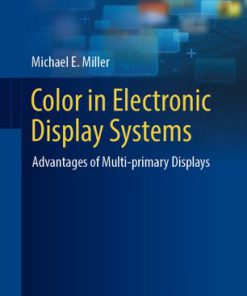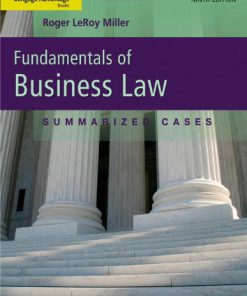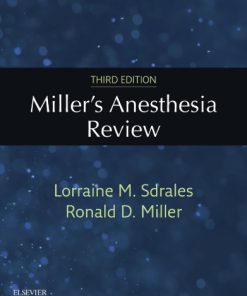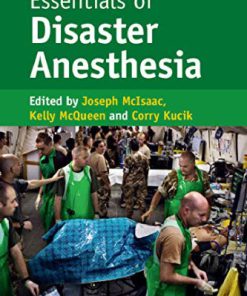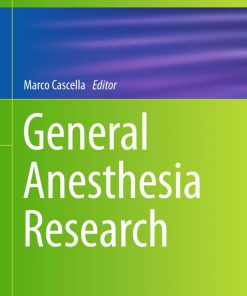Miller’s Anesthesia 9th Edition by Michael Gropper, Lars Eriksson, Lee Fleisher, Jeanine Wiener Kronish, Neal Cohen, Kate Leslie ISBN 0323811078 9780323811071
$50.00 Original price was: $50.00.$25.00Current price is: $25.00.
Miller’s Anesthesia 9th Edition by Michael Gropper, Lars I. Eriksson, Lee A. Fleisher, Jeanine P. Wiener Kronish, Neal H. Cohen, Kate Leslie – Ebook PDF Instant Download/Delivery: 0323811078, 978-0323811071
Full download Miller’s Anesthesia 9th Edition after payment
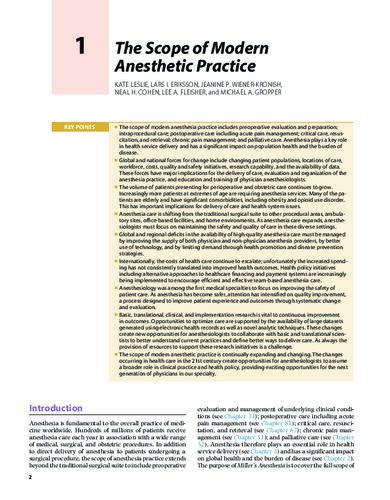
Product details:
ISBN 10: 0323811078
ISBN 13: 978-0323811071
Author: Michael Gropper, Lars I. Eriksson, Lee A. Fleisher, Jeanine P. Wiener Kronish, Neal H. Cohen, Kate Leslie
Miller’s Anesthesia 9th Table of contents:
VOLUME 1
Section I. Introduction
-
The Scope of Modern Anesthetic Practice
- Introduction
- Forces That Will Change Practice (Fig. 1.1)
- Conclusions
-
Anesthesia and Analgesia in the Global Context
- Introduction
- Section 1: Anesthesia and “Global Health”
- Section 2: Evolution of Anesthesia Care Models and Challenges Around the World
- Section 3: Essentials for Practice in Resource-Constrained Settings
- Appendix 1: Links and Useful Resources
- Conclusions
-
Perioperative Medicine
- Introduction
- Perioperative Management
- Models of Perioperative Care
- Conclusion
-
Informatics in Perioperative Medicine
- Introduction
- Computer Systems
- Computer Networks
- The Internet
- Information Security
- Standards for Healthcare Data Exchange
- Regulation of Electronic Data Exchange
- The Nature of Healthcare Information in the Anesthesia Encounter
- Development and Deployment of Anesthesia Information Management Systems
- Integration of Anesthesia Care Information with Operating Room Information Systems
- Development of Decision Support Tools
- Integration with the Enterprise Electronic Health Record
- Billing System Interactions
- Challenges in Anesthesia Information Management System Implementation
- Additional Uses for Collected Data
- Interactions of Electronic Devices with the Delivery of Anesthesia Care
- Conclusion
-
Quality Improvement in Anesthesia Practice and Patient Safety
- What Is Quality?
- Approaches to Quality Assessment
- Quality Improvement Measures and Tools
- Sources of Quality Improvement Information
- Examples of Quality Improvement Programs
- The Future: Research, Education, and Ethics
- Summary
-
Avoiding Patient Harm in Anesthesia: Human Performance and Patient Safety
- What this Chapter is About: An Overview
- Human Performance and Patient Safety in Anesthesia: Why is this Important?
- Nature of the Anesthesia Professional’s Operational Domain: A Dynamic and Complex Environment
- Nature of the Anesthesia Professional’s Work: Task Variation and Workload Management
- Patient Safety on the Individual and Team Level
- Patient Safety on the Organizational Level
- The Bigger Picture: Patient Safety Efforts on the U.S. National and International Level
- Conclusion and Outlook
- Appendix 6.1: Online Links and Valuable Public Sources
-
Patient Simulation
- What This Chapter Is About: An Overview
- Simulation in Anesthesia: Why Is It Important?
- Application of Simulation in Anesthesia and Healthcare
- History, Development, and Types of Simulators and Simulation
- Simulation Fidelity and Classification of Simulators
- Sites of Simulation
- Simulation Team Training Participants: Who Should Be Trained and in What Composition?
- Patient Simulation Timing: Announced in Advance Versus Unannounced in Advance
- Scopes of Simulation in Healthcare: The 12 Dimensions of Simulation
- Crisis Resource Management (ACRM; CRM): Part of Modern Patient Simulation Team Training
- Anatomy of a Patient Simulation Team Training Exercise
- Scenario Design and Execution: Knowing the Learning Objectives and Making It Real
- Debriefing: Heart and Soul of Patient Simulation
- Qualification and Certification of Simulation Instructors
- Accreditation of Simulation Programs, Sites, and Centers
- Benefits, Effectiveness, and Ecological Validity of Simulation Training
- Cost of Patient Simulation and Simulation Centers
- Using Simulation for Assessment of Clinical Performance
- Simulation Societies and Simulation Journals
- The Future of Patient Simulation in Anesthesia
- Appendix 7.1: Online Links and Useful Resources
-
Ethical Aspects of Anesthesia Care
- Ethical Theory
- Clinical Ethics
- Special Issues in Informed Consent and Informed Refusal
- Ethics of Anesthesia Involving Pregnant Women
- The Uncooperative Patient—Coercion and Restraint
- Truth-Telling—Disclosure of Errors and Apology
- Research Ethics
Section II. Anesthetic Physiology
-
Consciousness, Memory, and Anesthesia
- Introduction
- Consciousness
- Memory
- Organization and Function of Normal Memory
- Effects of Anesthetic Drugs on Declarative Memory Function in Humans
- Nonhuman Studies of Anesthetic Effects on Memory Processes and Behavior in the Medial Temporal Lobe
- Human and Nonhuman Studies of Anesthetic Effects on Fear Memory Systems
- Anesthetic Effects on Implicit Memory Function
-
Sleep Medicine
- Definition of Sleep
- Physiology
- How to Assess Sleep
- Sleep and Breathing
- Sleep and Anesthesia: Two Unequal Twins Influencing Perioperative Medicine
- Sleep and Sedation in the Intensive Care Unit
- Acknowledgment
- Cerebral Physiology and the Effects of Anesthetic Drugs
- The Anatomy of the Cerebral Circulation
- Effects of Anesthetics on Cerebral Blood Flow and Cerebral Metabolic Rate
- Other Effects of Anesthetics on Cerebral Physiology
- Cerebral Physiology in Pathologic States
- Neuromuscular Physiology and Pharmacology
- Neuromuscular Transmission
- Neuromuscular Junction
- Drug Effects on Postjunctional Receptors
- Biology of Prejunctional and Postjunctional Nicotinic Acetylcholine Receptors
- Neuromuscular Junction at Extremes of Age
- Respiratory Physiology and Pathophysiology
- Respiratory Physiology is Central to the Practice of Anesthesia
- Pulmonary Physiology in Health
- Ventilation
- Static Lung Volumes—Functional Residual Capacity
- Respiratory Mechanics
- Distribution of Inspired Gas
- Perfusion
- Clinical Assessment of Lung Function
- Intraoperative Respiratory Events
- Ventilation-Perfusion Matching During Anesthesia
- Factors that Influence Respiratory Function During Anesthesia
- Lung Function After Cardiac Surgery
- Protective Ventilation
- Postoperative Physiotherapy
- Intraoperative Hyperoxia
- Effect of Sleep on Respiration
- Cardiac Physiology
- Physiology of the Intact Heart
- Cellular Cardiac Physiology
- Control of Cardiac Function
- Gastrointestinal Physiology and Pathophysiology
- Introduction
- Gastrointestinal Anatomy and Function
- Transit Time in Health and Disease
- Methods of Evaluating Colonic Motility
- The Effects of General Anesthesia on Bowel Function
- Effect of Opioids on Bowel Function
- Effect of Open Abdominal Surgery, Ischemia, Stomas, and Bowel Anastomosis on Gastrointestinal Physiology and Function
- Gastrointestinal System Nociception
- Hepatic Physiology, Pathophysiology, and Anesthetic Considerations
- Anatomy of the Liver
- Hepatic Physiology
- Evaluation of the Liver
- Hepatic Pathophysiology
- Strategies for Minimizing Blood Loss
- Renal Anatomy, Physiology, Pharmacology, and Evaluation of Function
- Introduction
- Organization of the Kidney
- Induced Hypotension
- Basic Principles of Pharmacology
- Introduction
- Pharmacokinetic Models
- Special Interests in Anesthetic Pharmacokinetics
- Pharmacodynamic Principles
- Special Populations
- Summary
- Inhaled Anesthetics: Mechanisms of Action
- History
- Integrated Effects on Central Nervous System Function
- Identification of Molecular Sites of Anesthetic Action
- Cellular Mechanisms
- Simple Circuits and Complex Networks
- Research Strategies for the Future
- Summary
- Inhaled Anesthetic Uptake, Distribution, Metabolism, and Toxicity
- Introduction
- Uptake and Distribution of Inhaled Anesthetics
- Synthesis of the Model and Inhaled Anesthetic Induction: PK/PD
- Metabolism and Toxicity of Inhaled Anesthetics
- Pulmonary Pharmacology and Inhaled Anesthetics
- Introduction
- Inhaled Anesthetics
- Mucociliary Function and Surfactant
- Nonvolatile Inhaled Agents
- Summary
- Inhaled Anesthetics: Delivery Systems
- Standards and Guidelines for Anesthesia Workstations
- Functional Anatomy of the Anesthesia Workstation
- Checking Your Anesthesia Workstation
- Intravenous Anesthetics
- Propofol
- Barbiturates
- Benzodiazepines
- Flumazenil
- Phencyclidines (Ketamine)
- Etomidate
- Dexmedetomidine
- Droperidol
- Summary
- Opioids
- Introduction
- Pharmacology of Opioids
- Neurophysiologic Effects of Opioids
- Respiratory and Cardiovascular Effects of Opioids
- Endocrinologic Effects of Opioids
- Renal and Urodynamic Effects of Opioids
- Effects of Opioids on Digestive Organs
- Other Opioid Effects
- Pharmacokinetics and Pharmacodynamics of Opioids
- Anesthetic Techniques Using Opioids
- Drug Interactions with Opioids
- Nonopioid Pain Medications
- Introduction
- Nonsteroidal Anti-inflammatory Drugs
- Acetaminophen
- Calcium Channel Blockers
- Sodium Channel Blockers
- Intravenous Drug Delivery Systems
- Introduction
- Pharmacokinetic Considerations
- Pharmacodynamic Considerations
- Designing Dosing Regimens
- Intravenous Infusion Devices and Technologies
- Future Perspectives
- Pharmacology of Neuromuscular Blocking Drugs
- History and Clinical Use
- Principles of Action at the Neuromuscular Junction
- Pharmacology of Succinylcholine and Nondepolarizing Neuromuscular Blockers
- Special Populations
- Reversal (Antagonism) of Neuromuscular Blockade
- History and Current Management Practices
- Drugs Used to Reverse Neuromuscular Blockade
- Local Anesthetics
- Basic Pharmacology
- Mechanism of Action
- Clinical Pharmacology
- Toxicity
- Prolonged-Duration and Sensory-Selective Local Anesthetics
- Mechanisms of Failure and Genetic Variants
- Conclusions
People also search for Miller’s Anesthesia 9th:
baby miller anesthesia pdf
ronald miller anesthesia
dan miller anesthesia
amazon miller anesthesia
borrow miller’s anesthesia
Tags:
Michael Gropper,Lars Eriksson,Lee Fleisher,Jeanine Wiener Kronish,Neal Cohen, Kate Leslie,Miller’s,Anesthesia 9th
You may also like…
Medicine
Engineering
Color in Electronic Display Systems Advantages of Multi primary Displays Michael E. Miller
Commercial & Financial Law
Cengage Advantage Books Fundamentals of Business Law Summarized Cases 9th Edition Roger Leroy Miller






